The nervous systems of basally branching nemertea (palaeonemertea)
- PMID: 23785478
- PMCID: PMC3681988
- DOI: 10.1371/journal.pone.0066137
The nervous systems of basally branching nemertea (palaeonemertea)
Abstract
In recent years, a lot of studies have been published dealing with the anatomy of the nervous system in different spiralian species. The only nemertean species investigated in this context probably shows derived characters and thus the conditions found there are not useful in inferring the relationship between nemerteans and other spiralian taxa. Ingroup relationships within Nemertea are still unclear, but there is some agreement that the palaeonemerteans form a basal, paraphyletic grade. Thus, palaeonemertean species are likely the most informative when comparing with other invertebrate groups. We therefore analyzed the nervous system of several palaeonemertean species by combining histology and immunostaining. 3D reconstructions based on the aligned slices were performed to get an overall impression of the central nervous system, and immunohistochemistry was chosen to reveal fine structures and to be able to compare the data with recently published results. The insights presented here permit a first attempt to reconstruct the primary organization of the nemertean nervous system. This comparative analysis allows substantiating homology hypotheses for nerves of the peripheral nervous system. This study also provides evidence that the nemertean brain primarily consists of two lobes connected by a strong ventral commissure and one to several dorsal commissures. During nemertean evolution, the brain underwent continuous compartmentalization into a pair of dorsal and ventral lobes interconnected by commissures and lateral tracts. Given that this conclusion can be corroborated by cladistic analyses, nemerteans should share a common ancestor with spiralians that primarily have a simple brain consisting of paired medullary, frontally commissurized and reinforced cords. Such an organization resembles the situation found in presumably basally branching annelids or mollusks.
Conflict of interest statement
Figures

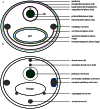





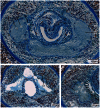
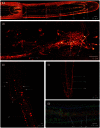





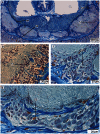
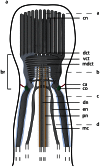



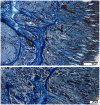
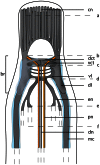
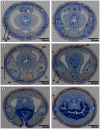
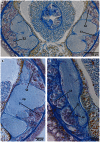
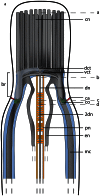


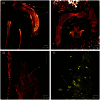


Similar articles
-
Development of the Nervous System of Carinina ochracea (Palaeonemer-tea, Nemertea).PLoS One. 2016 Oct 28;11(10):e0165649. doi: 10.1371/journal.pone.0165649. eCollection 2016. PLoS One. 2016. PMID: 27792762 Free PMC article.
-
Vestigial prototroch in a basal nemertean, Carinoma tremaphoros (Nemertea; Palaeonemertea).Evol Dev. 2004 Jul-Aug;6(4):219-26. doi: 10.1111/j.1525-142X.2004.04027.x. Evol Dev. 2004. PMID: 15230962
-
Lophotrochozoan neuroanatomy: An analysis of the brain and nervous system of Lineus viridis(Nemertea) using different staining techniques.Front Zool. 2011 Jul 19;8:17. doi: 10.1186/1742-9994-8-17. Front Zool. 2011. PMID: 21771310 Free PMC article.
-
From trochophore to pilidium and back again - a larva's journey.Int J Dev Biol. 2014;58(6-8):585-91. doi: 10.1387/ijdb.140090sm. Int J Dev Biol. 2014. PMID: 25690972 Review.
-
Larval nervous systems: true larval and precocious adult.J Exp Biol. 2015 Feb 15;218(Pt 4):629-36. doi: 10.1242/jeb.109603. J Exp Biol. 2015. PMID: 25696826 Review.
Cited by
-
Development of the Nervous System of Carinina ochracea (Palaeonemer-tea, Nemertea).PLoS One. 2016 Oct 28;11(10):e0165649. doi: 10.1371/journal.pone.0165649. eCollection 2016. PLoS One. 2016. PMID: 27792762 Free PMC article.
-
The development of the adult nervous system in the annelid Owenia fusiformis.Neural Dev. 2024 Feb 21;19(1):3. doi: 10.1186/s13064-024-00180-8. Neural Dev. 2024. PMID: 38383501 Free PMC article.
-
Palps across the tree - the neuronal innervation and development of sensory head appendages in Annelida.Front Neurosci. 2024 Jan 4;17:1310225. doi: 10.3389/fnins.2023.1310225. eCollection 2023. Front Neurosci. 2024. PMID: 38239828 Free PMC article.
-
On the role of the proventricle region in reproduction and regeneration in Typosyllis antoni (Annelida: Syllidae).BMC Evol Biol. 2016 Oct 4;16(1):196. doi: 10.1186/s12862-016-0770-5. BMC Evol Biol. 2016. PMID: 27716025 Free PMC article.
-
The central nervous system of Oweniidae (Annelida) and its implications for the structure of the ancestral annelid brain.Front Zool. 2019 Mar 12;16:6. doi: 10.1186/s12983-019-0305-1. eCollection 2019. Front Zool. 2019. PMID: 30911320 Free PMC article.
References
-
- Nordhausen W (1988) Impact of the nemertean Lineus viridis on its polychaete prey on an intertidal sandflat. Hydrobiologia 156: 39–46.
-
- Thiel M (1998) Nemertines as predators on tidal flats - High noon at low tide. Hydrobiologia 365: 241–250.
-
- Thiel M, Kruse I (2001) Status of the Nemertea as predators in marine ecosystems. Hydrobiologia 456: 21–32.
-
- Bürger O (1895) Die Nemertinen des Golfes von Neapel und der angrenzenden Meeres-Abschnitte. In Fauna und Flora des Golfes von Neapel und der angrenzenden Meeres-Abschnitte. Berlin: R Friedländer und Sohn. 743 p.
-
- Gibson R (1972) Nemerteans. London: Hutchinson University Library. 224 p.
Publication types
MeSH terms
LinkOut - more resources
Full Text Sources
Other Literature Sources

